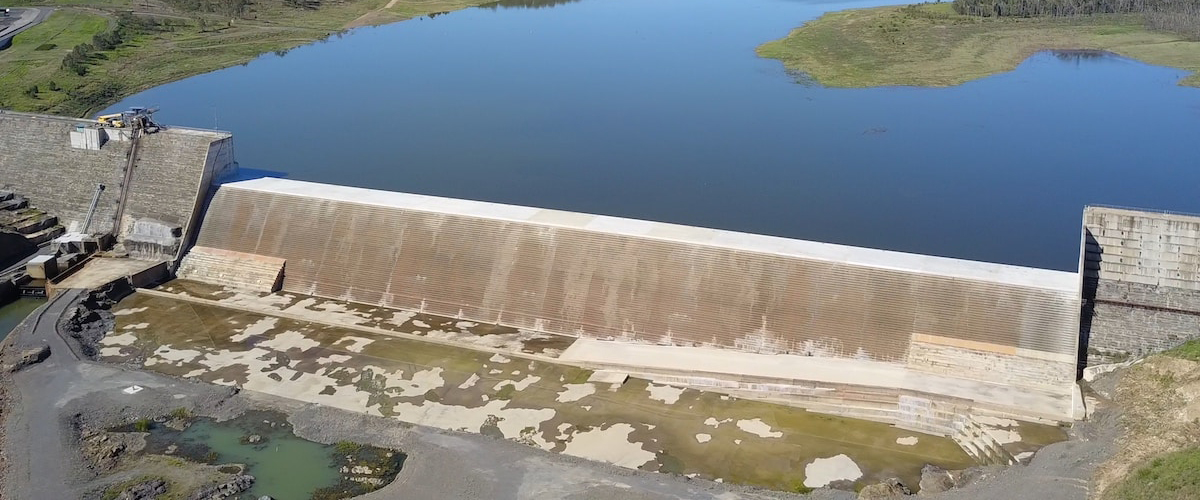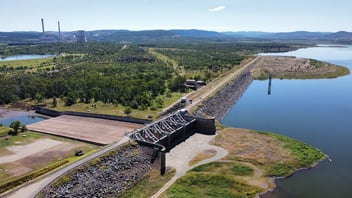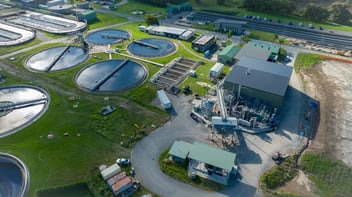Queensland utility to replace dam wall following extensive testing

Planning has begun to build an entirely new wall at Paradise Dam on the Burnett River near Bundaberg, with the Queensland Government announcing that the existing wall of the 300,000ML storage has been found to have too many faults to be repaired.
While the existing dam is safer now following Sunwater’s essential works program that lowered the supply level, a business case has commenced and environmental approvals are being sought for construction of a new dam wall.
Paradise Dam was constructed between 2003 and 2005 by the Burnett River Dam Alliance. Sunwater was directed to acquire the asset in 2005 following the construction.
A world-first testing program coordinated by Sunwater found proof of engineering flaws, but the new dam wall will meet stringent safety criteria and will ensure the new asset will reliably serve the community for at least 100 years.
Queensland Minister for Water Glenn Butcher said the priority is to restore the storage to its full capacity to ensure water security for the region moving forward.
“This is a significant milestone in our efforts to restore Paradise Dam to its original capacity. It is a win for the Bundaberg region and will be a major benefit for agricultural producers,” he said.
“A new wall will ensure the dam is a lifelong asset and will deliver for an even longer term than promised by the repair. The Queensland Government will always listen to the experts and the expert advice tells us we cannot repair the existing dam wall.
“We are not going to lose a minute, with Sunwater appointing its construction partner and early works at the site continuing full steam ahead to ensure the new dam wall can proceed as quickly as possible, once all approvals have been obtained.”
Novel testing
Sunwater has been progressing the Paradise Dam Improvement Project Detailed Business Case since December 2021, when the Queensland Government confirmed that the dam would be returned to its full height and original capacity.
Sunwater Chief Development Officer Mal Shepherd said that, as part of the project to restore Paradise Dam to its original height, Sunwater had been undertaking a program of intensive testing to inform design development.
“Through this testing, three unexpected new issues regarding the long-term strength and quality of the dam’s concrete were identified and investigated further. These issues involved swelling clay, cement leaching and carbonation within Paradise Dam’s concrete,” he said.
“As the issues were unprecedented, we developed a bespoke and world-first testing program with our partners and independent experts to conduct further investigations.
“Results from the testing program received in late 2023 confirmed that it is not possible to repair the existing dam to its original full supply level, as part of significant safety improvement works.”
The testing program put core samples of Paradise Dam’s concrete through a range of climatic and in-situ conditions applied under accelerated timeframes to understand how the concrete may perform over time, Shepherd said.
“Samples were treated with either ethylene glycol or a ‘wet and dry’ method before being subjected to compressive and tensile testing,” he said.
“Samples exposed to the treatments showed little resistance to the tests by crumbling and significantly reducing in strength.”
Finding flaws
Shepherd said the results from the bespoke testing program showed: “the newly identified issues resulted from a poor concrete mix in the original dam design and poor quality control during construction”.
“They also confirmed that Paradise Dam’s concrete will lose strength over time,” he said.
“The dam was built with a small amount of cement content and a far higher percentage of clay. There has since been an interaction between the clay and cement, which can’t be undone or removed.”
Results from the accelerated testing yielded a strength loss of approximately 75% from compression testing (crushing) and 35% from tensile testing (pulling).
“When compared to more than 900 publicly recorded roller compacted dams across the world, Paradise Dam is within the lowest first percentile for cementitious content,” Shepherd said.
“As the testing program was bespoke, it was important that the data be reliable and comprehensive.
“The program was therefore reviewed by a host of international and Australian experts, including an independent Technical Review Panel and companies Tatro Hinds, GHD, and KCB.”
What’s next?
Sunwater is now progressing a detailed business case for a new Paradise Dam wall, with project costs and timeframes to be confirmed as part of the process.
Sunwater has formed an alliance to deliver the project, appointing CPB Contractors/Georgiou as construction partner and GHD as the ongoing design partner. The alliance will ensure design and construction challenges are considered and addressed early, with options to reduce costs.
“Paradise Dam’s safety was ensured following the lowering of its wall, ensuring safe operation for many years to come,” said Sunwater CEO Glenn Stockton.
“However, the concrete quality of the dam means it cannot be repaired to last the many decades we expect from these assets. No one is more committed to providing water security for the Bundaberg region than Sunwater.”
Separate to planning for a new dam wall, Sunwater will also commence a detailed business case to expand the irrigation network within the Bundaberg Water Supply Scheme. The plan will build upon previous investigations to understand distribution constraints.
While determining details for the new wall at Paradise Dam and irrigation network capacity upgrades takes time, Sunwater will provide regular progress updates to the community.



